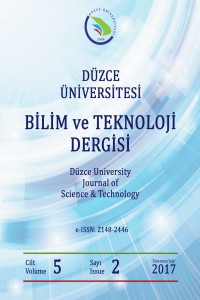Optimization Of Cross Sectional Geometry of 3d Printed Beams According To Pure Bending Strength withthe Same Amount of Filament
Abstract
In this study, it was aimed to sort 3D printed beams that will be produced with the same amount of filament according to bending strength. Thus a ranking was performed due to performance of the design points independently form the production time, energy consumption and amount of filament which is frequently used at rapid prototyping and manufacturing of plastic parts. Length of the modelled beams and the applied moments were kept constant, cross sectional geometries (circle, rectangle, equilateral triangle, rhomboid, ellipse and rounded rectangle) were taken as variables. Totally 2424 design alternatives of beams were created depending on 6 cross sectional geometries, 101 cross sectional areas and 4 different materials. These design alternatives were
mathematically modelled and then they were tested with Finite Element Analysis (FEA) and Regression Analysis (RA). Models were compared to each other statistically. At the end of the analyses, cross sectional geometries were ascendingly sorted with respect to stress values and deformations.
Keywords
References
- Biggins P, Hiltz J, Kusterbeck A. Bio-inspriedMaterialsandSensingSystems. Cambridge: RSC Pub; 2011.
- Milovanović J, Trajanović M. Medıcalapplications of rapidprototyping. MechanicalEngineering 2007; 5:79 – 85.
- Gibson I. Advanced ManufacturingTechnologyforMedical Applications: ReverseEngineering. Software Conversion andRapidPrototyping. West Sussex:JohnWiley&Sons; 2005.
- SubhransuMohapatra, PrasadDasappaNumericalPrediction of StiffnessandStrength of a HighlyComplexTopologyOptimizedThermoplasticPartdesignedfor 3D Printing SPE ANTEC™ Indianapolis 2016.
- LarsKrog, A. T. Application of Topology, SizingandShapeOptimizationMethodsto Optimal Design of Aircraft Components. Retrievedfrom Altair productdesign 2011.
- Baich, Liseli, andGuhaManogharan. "Study of infillprintparameters on mechanicalstrengthandproductioncost-time of 3D printed ABS parts." International Solid FreeformFabricationSymposium, Austin, TX. 2015.
- M. Iliescu E. Nuţu, B. ComănescuAppli edFinite Element MethodSimulation in 3D Printing, InternatıonalJournal Of MathematıcsAndComputersInSımulatıon, Issue 4, Volume 2, 2008, 305-312.
- Russell C. Hibbeler, Mechanics Of Materials, PearsonEducationCanada 2011.
- M. T. ÖZKAN and İ. TOKTAŞ, “Determination of the stress concentration factor Kt in a rectangular plate with a hole under tensile stress using different methods title ,” Materials Testing, vol. 58, no. 10, pp. 839–847, Oct. 2016.
- ANSYS Manual.
3 Boyutlu Baskısı Yapılacak Ankastre Kirişlerin Eşit Miktarda Filament Kullanımı İle Eğilme Mukavemetine Göre Kesit Geometrisi Optimizasyonu
Abstract
Bu çalışmada, aynı kesit alanı ve uzunluğundaki, eşit miktarlarda filament
kullanımı ile 3 boyutlu baskısı yapılacak ankastre kirişlerin eğilme mukavemeti
yönünden en iyi mekaniksel özelliği sağlayan kesit
geometrilerinin belirlenmesi hedeflenmiştir. Böylelikle, hızlı modellemede
ve plastik parçaların üretiminde sıkça kullanılan filament miktarı, üretim zamanı ve harcanan enerjiden bağımsız olarak,
tasarımlar arasında performansa göre bir sıralama yapılmıştır. Ankastre
kirişlerin tasarımların uzunluğu ve uygulanan kuvvetler sabit tutulmuş, içi dolu temel kesit geometri biçimleri (çember,
dikdörtgen, eşkenar üçgen, paralel kenar, elips ve köşeleri yuvarlatılmış
dikdörtgen) değiştirilmiştir. Ayrıca, dört farklı filament malzemesi, eğilme
mukavemeti yönünden karşılaştırılmıştır. 6 kesit şekline, 101 kesit alanına ve
4 farklı malzemeye bağlı olarak toplam 2424 adet tasarım alternatifi
oluşturulmuştur. Bu tasarım alternatifleri, önce matematiksel olarak modellenmiş, sonra sonlu
elemanlar yöntemi (FEM) ve regresyon analizi ile test edilmiştir. Tüm modellerin istatiksel analizleri yapılarak
karşılaştırılmıştır. Yapılan analizler sonucunda, en düşükten büyüğe doğru
gerilmelere ve deformasyonlara uğrayan kesit geometrisi biçimleri
sıralanmıştır.
Keywords
References
- Biggins P, Hiltz J, Kusterbeck A. Bio-inspriedMaterialsandSensingSystems. Cambridge: RSC Pub; 2011.
- Milovanović J, Trajanović M. Medıcalapplications of rapidprototyping. MechanicalEngineering 2007; 5:79 – 85.
- Gibson I. Advanced ManufacturingTechnologyforMedical Applications: ReverseEngineering. Software Conversion andRapidPrototyping. West Sussex:JohnWiley&Sons; 2005.
- SubhransuMohapatra, PrasadDasappaNumericalPrediction of StiffnessandStrength of a HighlyComplexTopologyOptimizedThermoplasticPartdesignedfor 3D Printing SPE ANTEC™ Indianapolis 2016.
- LarsKrog, A. T. Application of Topology, SizingandShapeOptimizationMethodsto Optimal Design of Aircraft Components. Retrievedfrom Altair productdesign 2011.
- Baich, Liseli, andGuhaManogharan. "Study of infillprintparameters on mechanicalstrengthandproductioncost-time of 3D printed ABS parts." International Solid FreeformFabricationSymposium, Austin, TX. 2015.
- M. Iliescu E. Nuţu, B. ComănescuAppli edFinite Element MethodSimulation in 3D Printing, InternatıonalJournal Of MathematıcsAndComputersInSımulatıon, Issue 4, Volume 2, 2008, 305-312.
- Russell C. Hibbeler, Mechanics Of Materials, PearsonEducationCanada 2011.
- M. T. ÖZKAN and İ. TOKTAŞ, “Determination of the stress concentration factor Kt in a rectangular plate with a hole under tensile stress using different methods title ,” Materials Testing, vol. 58, no. 10, pp. 839–847, Oct. 2016.
- ANSYS Manual.
Details
| Primary Language | Turkish |
|---|---|
| Subjects | Engineering |
| Journal Section | Articles |
| Authors | |
| Publication Date | July 31, 2017 |
| Published in Issue | Year 2017 Volume: 5 Issue: 2 |

